|

Highly Creditable
Puccini's 'Tosca' at the Verona Arena,
reviewed by ROBERT HUGILL
The Verona Arena is a unique venue, providing opera out of doors to a huge audience in an amphitheatre without any amplification. We saw the final performance of this year's production of Tosca on Friday 1 August 2008. But before coming to the performance, it is perhaps necessary to consider the performance space and its requirements and limitations as these have a very big effect on the end result, both the sound and the look of the evenings event.
The Verona Arena is the 2nd largest Roman amphitheatre in Italy, second only to the Colosseum in size. Its acoustics mean that voices carry in a remarkable fashion but inevitably it is prone to odd acoustical effects. The opera is staged without a proscenium and with little stage machinery. Singers must project both their voices and their dramatic performance into the huge acting spaces and dominate the large orchestra.
Similarly Hugo De Ana's production had to be writ large to have the required effect. De Ana, who designed both sets and costumes as well as directing, opted for a traditional period setting but in place of representative sets there were huge sculptural pieces. The stage was dominated by pieces of a statue of a giant angel (head, hand and arm wielding a sword), obviously inspired by the angel which is supposed to loom over the Act 3. In Act 1, the church was invoked by a huge version of Cavaradossi's painting. This was later dismantled and removed by supers who also brought on immense crosses and candle sticks for the Te Deum. A feature of the production was De Ana's use of supers to provide movement on the stage and to manipulate a whole series of props. Sometimes this meant, in scenes such as in the Palazzo Farnese, a rather over-populated stage picture.
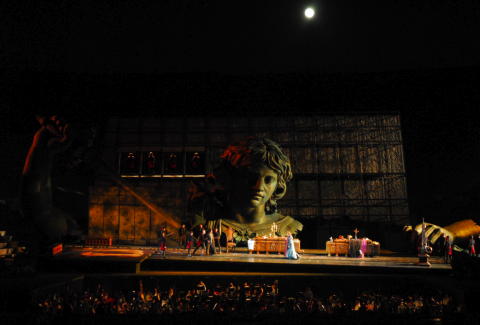
The Palazzo Farnese scene from Act II of Puccini's 'Tosca' at the Verona Arena. Photo © 2008 Maurizio Brenzoni
|
The sound quality of the Arena took some time to get used to, but all of the voices registered though one or two of the men did not project as well as could be hoped.
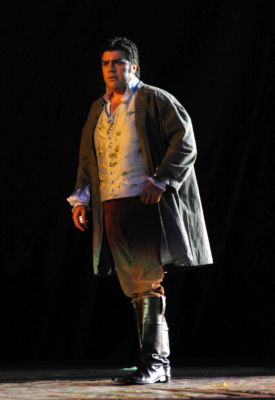
Carlo Ventre as Cavaradossi in 'Tosca' at the Verona Arena. Photo © 2008 Maurizio Brenzoni
|
Carlos Ventre, as Cavaradossi, had an attractive lyric tenor voice with a fine ability to sing both quietly and at mezzo-voce. His Cavaradossi was rather a stock figure, redeemed by some lovely singing. For the bigger moments he had an unfortunate tendency to push his voice, perhaps in an attempt to punch above his weight vocally. This seemed to succeed with the audience who encouraged him to repeat E luce van le stelle.
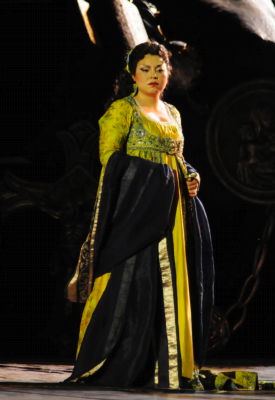
Hui He in the title role of 'Tosca' at the Verona Arena. Photo © 2008 Maurizio Brenzoni
|
As Tosca, the Chinese soprano Hui He was possessed of a lovely warm voice with an attractive vibrato which was thankfully not over pronounced. Perhaps her top range lacked the necessary refulgence but this is difficult to judge given the Arena's particular acoustics. Like Carlos Ventre, Hui He's gestures were rather stock and her acting telegraphic; maybe this is what is needed in the Arena's vast spaces. Hui He was persuaded to encore Vissi d'arte, a performance notable for some lovely controlled quiet singing, though there were moments where Hui He's voice did not quite do what was wanted and she approached some notes from rather too far below. But the total result was creditable and attractive. Neither singer quite struck sparks off the other and, frankly, I felt it looked as if Tosca and Cavaradossi's relationship had nearly run its course.
Nor did Hui He's Tosca and Alberto Mastromarino's Scarpia ever quite generate enough heat between them in their scenes. Mastromarino cut a striking figure on stage though his fuzzy wig was perhaps a mistake; the end result was that he looked more effete than terrifying. His stage persona was a little too warm and his lovely baritone voice seemed to lack the weight and edge to impose itself when required. This was very noticeable in the Te Deum in Act 1 when Mastromarino had to cope not only with the orchestra and chorus but with the repeated gun explosions (from a real gun placed high up in the Arena) and a chorus of bishops in gaudy copes and mitres. In fact, De Ana's staging of the Te Deum seemed to be more about stage spectacle than either realism or fidelity to Puccini's intentions.
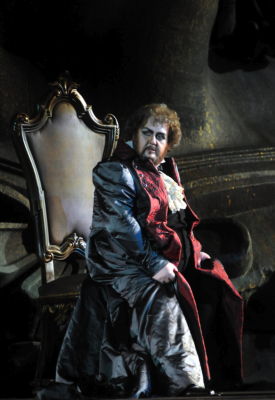
Alberto Mastromarino as Scarpio in Act II of 'Tosca' at the Verona Arena. Photo © 2008 Maurizio Brenzoni
|
In Act 2 it was similarly unfortunate that the acoustics of the Arena meant that the off stage female chorus were so loud that they dominated the soundscape, masking Scarpia's scene with Cavaradossi. Later in the scene Mastromarino's Scarpia seemed a little too caring and solicitous of Tosca, without any of the underlying threat that is surely required.
The shepherd in Act 3 was well taken by Alessandra Gambino and, of course, the space of the Arena came into its own as the bells of Rome's churches sounded, spread out across the sound stage.
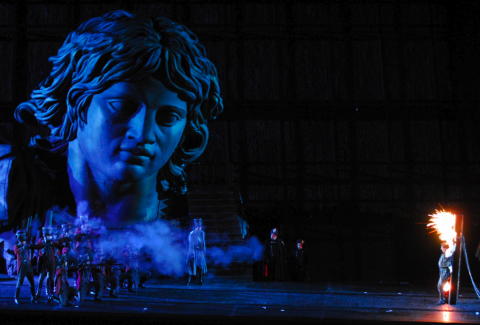
Cavaradossi's execution at the Castel Sant'Angelo from Act III of Puccini's 'Tosca' at the Verona Arena. Photo © 2008 Maurizio Brenzoni
|
By the end of the opera the audience's attention was perhaps almost as much on the accompanying lightening and considerations of when the threatened storm would break (thankfully after the opera had concluded) But Hui He and Carlos Ventre brought things to a noble and moving conclusion. De Ana's final pensée was to have Tosca appear a-top the giant head, holding a crucifix aloft, in lieu of a leap to her death.
Hui He, Carlos Ventre and Alberto Mastromarino had to cope not only with the open spaces of the Arena but also De Ana's production, which seemed to value spectacle above character. It is a testament to their strong musical values that they emerged creditably and they were ably supported by the Sacristan of Gianfranco Montresor, the Angelotti of Elia Todisco, the Spoleta of Antonio Feltracco and the Sciarrone of Nicolo Ceriani.
The orchestra under Giuliano Carella played admirably. Carella's main job seemed to be to act as traffic policeman to keep everything together, a job he did remarkably well. His speeds were, understandably, on the steady side but the result was a musically coherent whole.
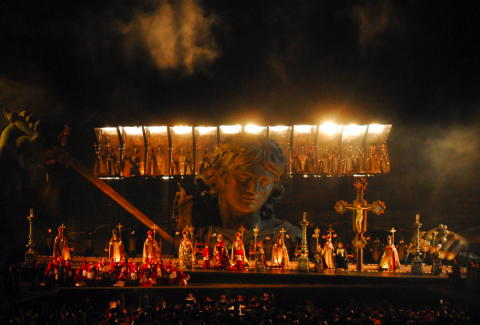
The 'Te Deum' Act I finale from Puccini's 'Tosca' at the Verona Arena. Photo © 2008 Maurizio Brenzoni
|
Opera at the arena is very much about spectacle and Hugo De Ana's extravagant production delivered this. But cast and conductor ensured that musical values were still adhered to, to create a highly creditable performance.
Copyright © 7 August 2008
Robert Hugill, London UK
 PUCCINI'S 'TOSCA' AT LOS ANGELES OPERA
'TOSCA' AT THE BREGENZ FESTIVAL
ENGLISH TOURING OPERA'S 'TOSCA'
'TOSCA' AT GUT IMMLING SUMMER MUSIC FESTIVAL
LUCIANO PAVAROTTI AS CAVARADOSSI AT COVENT GARDEN
PUCCINI'S 'TOSCA' AT LOS ANGELES OPERA
'TOSCA' AT THE BREGENZ FESTIVAL
ENGLISH TOURING OPERA'S 'TOSCA'
'TOSCA' AT GUT IMMLING SUMMER MUSIC FESTIVAL
LUCIANO PAVAROTTI AS CAVARADOSSI AT COVENT GARDEN
| 
